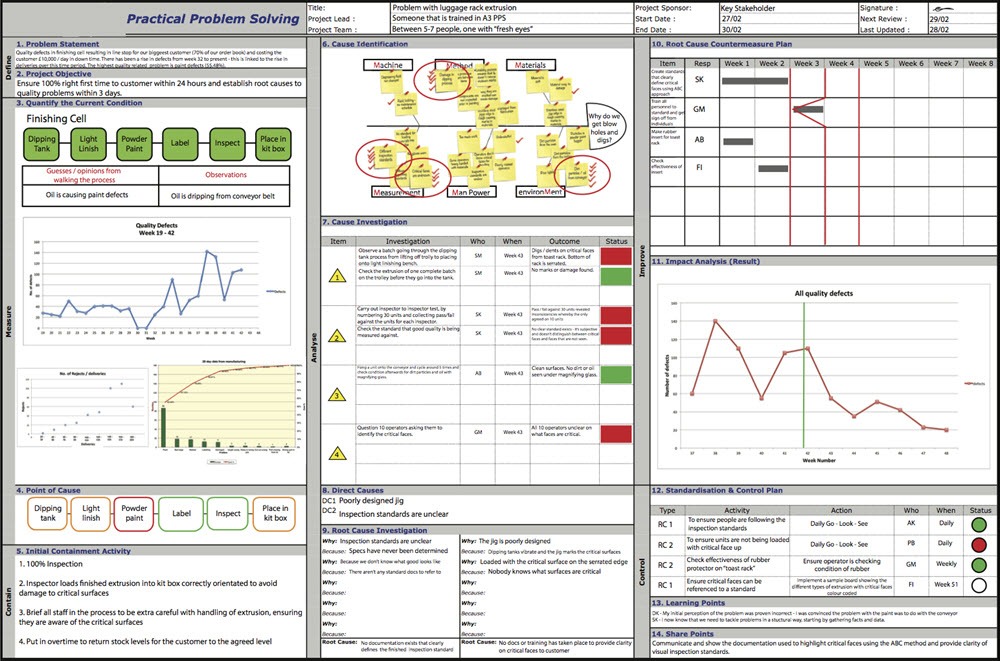A major part of our everyday work routine is definitely related to problem solving. Whether big or small, problems are unavoidable in our work. But, if you try to eliminate a problem as fast as possible, you might have to face that same problem over again. So, instead of combating only the symptoms, one needs to dig deep and find out the root cause. Proper root cause analysis will prevent having to deal with repeated problems.
A3 problem solving is a good example on how problems should be efficiently removed. Based on simple ideas and steps, the A3 problem solving model provides direction on ways to deal with problems via active communication, simple structuring and good collaboration.
The A3 Report
The A3 report is a one page document that reflects the outcomes of the whole A3 problem solving process. Most times, it contains seven steps but it could also have some other disparities. The following steps can be seen in a report;
- Background of problem
- Present situation
- Set goals and objectives
- Root cause analysis (RCA)
- Countermeasure
- Implementation strategy
- Confirmation of effect and follow-up
The A3 Problem Solving Process
A3 is a lean thinking procedure where the owner of the problem goes through the several stages until there is a right solution to implement. The problem owner needs to actively communicate with others on the project.
Here are the various steps of the A3 problem solving process.
Background of Problem
The very first step to solving a problem is to simplify and shortly describe the problem. This is the point to begin with, where the problem owner has to include context and create the support that the next steps need.
Present Situation
A problem owner has to describe the present situation in the particular location where the problem appears before the problem can be properly addressed.
During this stage, the several processes which exist around the area of the problem have to be mapped out. This will enable you to view the bigger picture and also find out the root cause.
Set Goals and Objectives
Once the present situation is sorted, then you need to set your goals and objectives. You should know that at this particular stage, you still haven’t got the whole picture.
Therefore, once you have gone through the remaining stages down to the ‘follow up’, then you can do more work on this stage by adding more information to the first set of goals.
Root Cause Analysis (RCA)
As stated earlier, if you decide to combat the issue immediately, only the symptoms will get treated. This means that you only scratched the surface and left the root cause untouched. Doing this will only make the same problem reoccur again later.
Hence, once you have gotten a good comprehension of how the A3 problem solving processes work and also identified the first set of goals, then, you have to find out the root cause of the issue. To do this, you can make use of different strategies, for instance, the 5 whys.
Countermeasures
After finding out the root cause of the problem, then you can start proffering solutions. Even from this point, you can decide to go back and include more information to the initial objectives. In every case, the countermeasures would lead to a vivid comprehension of how the objectives can be achieved.
Implementation Strategy
After getting all the countermeasures in place, then you have to come up with an implementation strategy which has to include the set of actions which will be applied to set up all the countermeasures. Assigning each task with their due date to responsible persons can also be very helpful.
Confirmation of Effect and Follow Up
This final step is vital for getting a culture of continual development established. Measuring the definite outcomes and confirming the impact of the countermeasures is very important. You should note that whether the outcome is positive or negative, the important thing is to take action. If the real outcome is different for the one that was predicted, then, you should alter the plan, activate it and then follow up.
However, if the effect is a positive one, then you should communicate the development to every employee in the organisation and eventually adopt it as the organisation’s standard.
